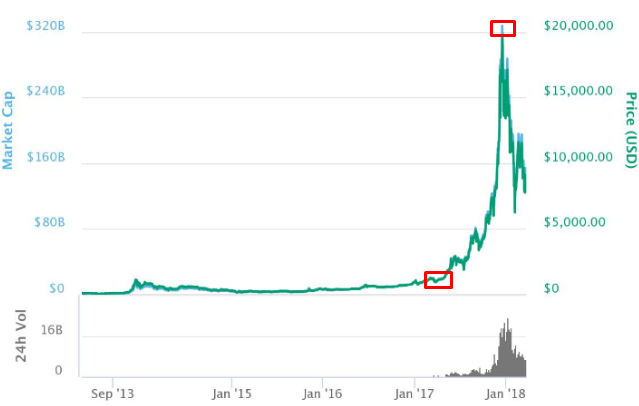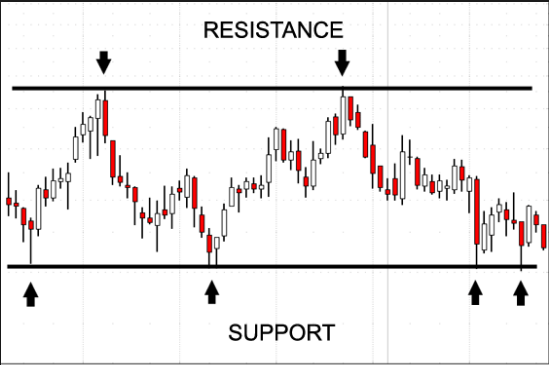3 Reasons to Not Sell in a Cryptocurrency Down Market
Last Updated: 1st November 2018
Given the extreme volatility that is inherent to the cryptocurrency market, the urge to sell in periods of market decline is only natural. However, in this article I will explore 3 key reasons why investors should resist such an urge, and instead, consider not selling their cryptocurrency assets during a market downturn.
The 3 reasons are as follows:
- Timing the market is impossible.
- Do the fundamentals check out?
- Technical Analysis: Has the cryptocurrency hit a key support level?
Timing the market is impossible
Timing the market simply means an investor’s ability to purchase a cryptocurrency before it experiences a large appreciation in price, and an investor’s ability to sell a cryptocurrency before its price starts to trend downwards. Both scenarios are the best of both worlds because an investor is able to experience 100% of any price gains, as well as avoid 100% of any price depreciation.
To illustrate, consider the historical price movements of Bitcoin displayed above. The first red rectangle at the bottom of the chart indicates a perfect buying opportunity, just before the price run-up that Bitcoin experienced. Likewise, the second red rectangle at the top of the chart indicates a perfect selling opportunity. Both scenarios are incredibly difficult, if not impossible to predict. There is no scientific reason to explain why Bitcoin started appreciating massively in price at that given time, similarly, there is no scientific reason to explain why it started to depreciate in price at that specific point in time.
The exercise of timing the market is incredibly difficult, and therefore, an investor should never trick themselves into selling a cryptocurrency because “the time is right”.
Do the fundamentals check out?
The philosophy of investing in a financial asset, not just cryptocurrency, for its fundamentals originates from American investor, Benjamin Graham. This technique was later popularised by his protégé, Warren Buffet. Buffet was able to demonstrate that by investing in fundamentally sound businesses, i.e. businesses that had a large potential for earnings growth, you could outperform the market.
This technique of fundamental analysis has been taken and applied to the cryptocurrency market by many people. However, because fundamental analysis focuses heavily on the earnings of a company, and cryptocurrencies do not produce earnings in the same way a company does, it has been modified. The fundamentals, with respect to a cryptocurrency, now commonly refers to:
- The quality of the team
- Is the use case of the cryptocurrency viable?
- What industry is the cryptocurrency attempting to disrupt?
- What partnerships are in place?
- The quality of the whitepaper
By no means is this an exhaustive list of questions an investor should ask themselves before purchasing a cryptocurrency, but these are types of questions that they should ask if they value the fundamental approach to investing.
If an investor has a high-level of conviction when it comes to these questions, the short-term volatility should be no concern to him. Typically, fundamental investors are also long-term investors who look to hold on to an asset for a period of 10 years or more. Therefore, in a such a volatile market that cryptocurrency is, day-to-day volatility should be no concern if you believe in the fundamentals of a cryptocurrency.
Technical Analysis: Has the cryptocurrency hit a key support level?
For those that do not subscribe to the fundamental approach, perhaps technical analysis may be a good reason not to sell in a down market. One key question an investor should ask themselves is: “Has the cryptocurrency hit a key support level?”. Support in this context simply means the price at which a cryptocurrency will find support as it falls. Depending on how bearish the market is, the price will tend to bounce off the support level without breaking through it. This provides an indication as to the minimum price you can expect a cryptocurrency to trade for.
If you notice the price of a cryptocurrency bouncing between a wide resistance and support line, and the support line is at a price level you are comfortable with, then perhaps you should reconsider selling your cryptocurrency assets.
Conclusion
If you choose to sell your cryptocurrencies, you should always ensure that you are able to give a step-by-step reason as to exactly why it is you are selling your stake. If you cannot, then it may suggest that you are selling out of fear.
Minimizing the amount of emotion that seeps into your decision-making process should always be the goal for any investor, because if you can beat your emotions, you stand a better chance of beating the market.






